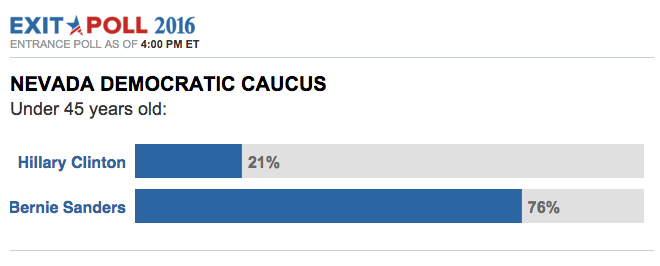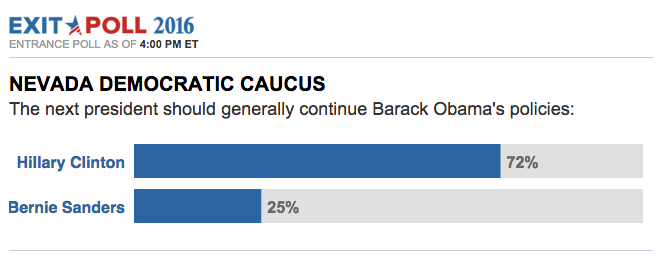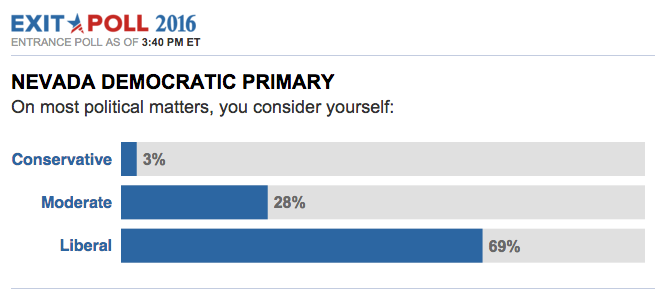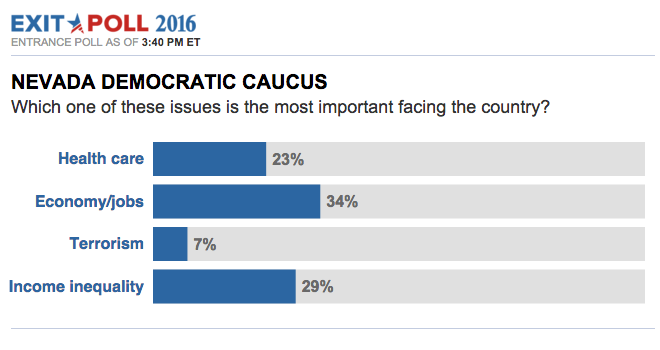Live Nevada Democratic Caucuses Entrance Poll Analysis
Here's what we're learning about today's Nevada voters.
— -- A vast influx of liberals is shaping the Democratic caucus turnout in Nevada – a boost for Bernie Sanders that’s countered by Hillary Clinton’s support among caucus-goers who favor continuing Barack Obama’s policies rather than more liberal ones. And as in previous contests, a vast age gap divides the party.
ABC News has projected Hillary Clinton will win the Nevada Democratic caucuses, based on vote analysis.
Among caucus goers under age 45, three-quarters in entrance poll results support Sanders for the nomination; among those 45 and older, Clinton easily prevails.

There’s also a wave of newcomers in the caucuses: Two-thirds say it’s their first time attending a Nevada Democratic presidential caucus. Sanders does better in this group, while Clinton pushes back strongly among repeat attenders.
A remarkable seven in 10 caucus goers describe themselves as liberals, including a third “very” liberal – far higher than their share in the 2008 Nevada caucuses, 45 and 18 percent, respectively. Liberals are a better group for Sanders, moderates for Clinton.
At the same time, about half of caucus goers say the next president should generally continue Obama’s policies, a very strong group for Clinton; about four in 10 prefer more liberal policies, an overwhelmingly pro-Sanders group. (There was a 55-33 percent split on this question in Iowa, where Clinton narrowly won, compared with 40-42 percent in in New Hampshire, where Sanders romped.)

In another sharp dividing line, about half of caucus goers in Nevada put a priority on a candidate who’s electable or experienced, strong Clinton groups here as in Iowa and New Hampshire. The rest want someone with who’s honest and trustworthy or “cares about people like me,” both big Sanders groups, again here as elsewhere.
A gender gap is apparent in these results, with more women favoring Clinton, more men for Sanders. Turnout among women may be down from 2008 – we’ll continue to monitor.
Nevada is the first state on the Democratic calendar with significant turnout among minorities. Nonwhites account for more than a third of caucus goers. While nonwhites have been strong for Clinton in national polling, these results indicate a closer contest in this group in Nevada.
Among other divisions are education and income groups – with Clinton doing better among more educated and higher-income caucus-goers, and Sanders prevailing among those with lower incomes and less schooling. (The age gap likely contributes here.)

In terms of party loyalties, just about two in 10 participants identify themselves as independents – fairly similar to the 2008 Nevada caucuses and the Iowa contest this year, and far below the share of independents in New Hampshire. Independents are a huge group for Sanders; prevailing among mainline Democrats will be key for Clinton if she’s to prevail.
Dealing with the economy and jobs is the top issue for Democratic caucus goers, and those who select it divide evenly between Clinton and Sanders. The next most cited issues are income inequality, strong for Sanders, and health care, strong for Clinton.
Sanders is winning a remarkable 77 percent of independents – his best showing in this group to date.

Clinton in turn wins 77 percent of voters focused on the candidate who “can win in November” – but it’s last on the list of desired attributes. Among those who care most about a candidate who “cares about people like me,” eight in 10 back Sanders, as do even more, 85 percent, of those looking for a candidate they see as honest and trustworthy. That said, among those who prioritize a candidate’s experience, almost all – 92 percent – prefer Clinton.
Highlighting the age gap, 18 percent of caucus-goers are younger than 30, compared with 13 percent in 2008 – and 83 percent of them favor Sanders, continuing his absolute dominance among young voters. Among those age 30 to 44, Sanders also easily prevails, with 69 percent support. As noted, Clinton comes back with those 45 and up.

Hispanics – nearly two in 10 caucus participants – are tilting to Sanders, with 54 percent support – a serious challenge to Clinton among nonwhites. Clinton won 64 percent of Hispanics in Nevada in 2008, when she beat Barack Obama in the state’s caucuses by 7 percentage points.
Also of interest in Nevada are union household voters – they account for a quarter of caucus participants in these results. Clinton’s doing better than Sanders in this group, regardless of the decision of an influential union there not to endorse either candidate.
Also on the entrance poll is a question asking caucus-goers who they think would best handle nominations to the U.S. Supreme Court. Clinton prevails on this question in these results – but the margin is a close one.
A few additional comparisons to Clinton’s performance in the 2008 Nevada caucuses may help inform today’s results:
-While never her strongest group, Clinton won 33 percent of independents in Nevada in 2008. She’s winning just 18 percent of them in entrance poll results today.
-Clinton won liberals in 2008, with 48 percent support against Obama and John Edwards. She’s six points below that mark today, and, as noted, there many are more of them. That said, she is doing better among moderates, with 57 percent support, 11 points better than her result in this group in ‘08.
-Clinton won lower-income voters in Nevada in 2008, with 50 percent support from those with annual incomes less than $50,000. She’s running 6 points lower in that group now, per the entrance poll.
-Reiterating from our last note, she won 64 percent of Latinos in 2008, vs. just 43 percent in today’s entrance poll result – again, a dramatic shift.
Also - the following table lists each candidate’s support profile – the share of their voters in each group. Six in 10 Clinton voters are women, vs. 46 percent of Sanders’. Fifty-seven percent of Clinton’s are white, vs. 64 percent of Sanders’. Seventy-seven percent of Sanders’ supporters are liberals, vs. 62 percent of Clinton’s.

Most striking are these:
-86 percent of Sanders’ voters are looking for a candidate with honesty or empathy; 79 percent of Clinton’s are focused on experience or electability.
-75 percent of Clinton supporters want the next president to continue Obama’s policies. Sixty-seven percent of Sanders’ voters want a more liberal approach.
-71 percent of Sanders’ voters are attending their first caucus, vs. 57 percent of Clinton’s.
-41 percent of Sanders’ voters are mainly concerned with income inequality, vs. 17 percent of Clinton’s.
While Sanders is winning Hispanics in the entrance poll results, Clinton trounces him among blacks, 74-24 percent. (The sample size is quite small, 89 cases, but even with a 14-point margin of sampling error, it’s a significant result.)
Among caucus goers who decided in just the last few days, Clinton won by 50-37 percent. (The rest voted “uncommitted,” as you can do in these caucuses.) Results are mixed among those who decided less recently, but with a big Sanders lead, 61-38 percent, among those who decided between a week and a month ago.
Here’s some “why Clinton won” narrative:
Hillary Clinton weathered an influx of liberals in the Nevada Democratic caucuses to prevail with help from a gender gap, broad support from blacks and older voters and a major boost from Barack Obama loyalists.
A battle between hearts and heads was apparent, with Clinton trouncing Sanders among voters focused on experience and electability, while Sanders whomped Clinton among those looking chiefly for a candidate who’s honest and trustworthy or who “cares about people like me.”
Among caucus goers under age 45, 76 supported Sanders in the ABC News entrance poll. Sanders’ support soared to 84 percent of those younger than 30, continuing his absolute dominance in this group.That said, Clinton won by more than 2-1 among voters age 45 and older – and they accounted for nearly two-thirds of the caucus turnout.
A remarkable seven in 10 caucus goers described themselves as liberals, including a third “very” liberal – far higher than their share in the 2008 Nevada caucuses, 45 and 18 percent, respectively. Liberals, however, did not break as strongly for Sanders as they did in New Hampshire. Here they backed him by 51-46 percent, while Clinton countered with 59 percent support among moderates, 13 points better than her result in this group in Nevada in ‘08. (PHIL4)
Notably, half of caucus goers said the next president should generally continue Obama’s policies, and this was a very strong group for Clinton – she won 75 percent of their votes. Sanders got 77 percent of those who prefer more liberal policies, but there were fewer of them.
In the first state this year with sizable numbers of minority voters, Sanders won Hispanics, 53-45 percent – in a group Clinton won with 64 percent support in 2008. That said, Clinton, in return, trounced Sanders among blacks, 76-23 percent. Blacks make up a much larger share of voters in the next state ahead for the Democrats, South Carolina.
As noted, the gender gap was sharp – 57 percent for Clinton among women, 53 percent for Sanders among men.
In terms of party loyalties, about two in 10 participants identified themselves as independents – similar to the 2008 Nevada caucuses and the Iowa contest this year, and far below the share of independents in New Hampshire. Independents were a huge group for Sanders, with 71 percent supporting him. But Clinton prevailed among mainline Democrats, with 58 percent – enough to tip the contest her way.
Among other divisions are education and income groups – with Clinton doing better among more educated and higher-income caucus-goers and Sanders prevailing among those with lower incomes and less schooling. (The age gap likely contributes here.) Clinton won post-graduates by a broad 62-35 percent and voters with $100,000-plus incomes by 54-42 percent; the vote was much closer among others.
Specifically in the hearts-vs-heads battle, Clinton won 80 percent of voters focused on the candidate who “can win in November” and even more – 92 percent – of those most interested in experience. Among those who instead cared most about a candidate who “cares about people like me,” 72 percent took Sanders, as did even more, 82 percent, of those looking for a candidate they see as honest and trustworthy.
Dealing with the economy and jobs was the top issue for Democratic caucus goers, and those who selected it went for Clinton overs Sanders by 55-41 percent. Next were income inequality, strong for Sanders, and health care, strong for Clinton.
A wave of newcomers showed up: Six in 10 said it was their first time attending a Nevada Democratic presidential caucus. Sanders did better in this group, with 53 percent support. But Clinton pushed back strongly among repeat attenders, with 62 percent.
Union household voters accounted for a quarter of caucus participants. Clinton won them, 54-43 percent, regardless of the decision of an influential union there not to endorse either candidate.
Also on the entrance poll was a question asking caucus-goers who they think would best handle nominations to the U.S. Supreme Court. Clinton prevailed on this question as well, 54-43 percent over Sanders.
Finally, among caucus goers who decided in just the last few days, Clinton won by 51-37 percent. (The rest voted “uncommitted.”) Results were mixed among those who decided less recently, but with a big Sanders lead, 58-40 percent, among those who decided between a week and a month ago. There were, however, not enough of them to save the day for the Vermonter.
Get real-time updates as this story unfolds. To start, just "star" this story in ABC News' phone app. Download ABC News for iPhone here or ABC News for Android here.